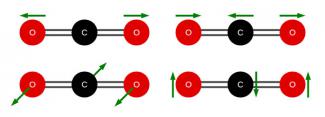A patented technology from NETL inventors offers a cost-effective way to enable low-carbon electricity generation and efficient fuel processing, among other benefits.
This game-changing technology is a physical solvent that provides a way for chemical plants, power plants, refineries and others to separate carbon dioxide (CO2), hydrogen sulfide (H2S) from hydrogen (H2), carbon monoxide, (CO), and nitrogen (N2). The novel solvent selectively removes weak acid gases, such as CO2, from high-pressure gas streams composed of CO2 and hydrogen, such as those found in carbon capture, hydrogen purification, and natural gas sweetening applications. What makes NETL’s solvents unique is its ability to use waste heat rather than electricity to drive the solvent’s regeneration. This translates to cost savings realized by increased efficiency.
Solvent-based CO2 capture involves chemical or physical absorption of CO2 from a gas stream. Physical solvents absorb CO2 from syngas (a combination of hydrogen and carbon monoxide, typically synthesized during coal gasification) into a liquid carrier. The absorption liquid is regenerated for further use by increasing the temperature or reducing the pressure to allow the CO2 to flash out of the liquid, much like opening a bottle of carbonated water. Typically, CO2 absorption takes place in high-pressure, low-temperature conditions where most of the water vapor has been separated from the gas stream. However, cooling the fuel gas stream for these processes requires energy and capital costs. Therefore, a need exists for hydrophobic solvents that would absorb as much CO2 and as little water as possible at temperatures above 40 degrees Celsius.
Commercial technologies currently on the market must operate at cooler temperatures (+10 to -10 degrees Celsius), requiring additional energy for the solvents to be chilled and regenerated for further use. NETL’s solvent can operate at higher temperatures (above room temperature) and use waste heat to regenerate. This means chemical plants, power plants, refineries, among others using the solvent can reduce their cost of capturing CO2 from these sources. Using waste heat can increase the amount of net electricity production by up to 50 MW at a 500 MW-scale power plant with CO2 capture.
NETL researchers designed their hydrophobic, physical solvent to remove CO2 and other acid gases from many different high-pressure applications including CO2 capture, hydrogen purification, and natural gas sweetening. This technology overcomes typical issues with high vapor pressure, water sorption, and poor selectivity associated with other physical solvents for CO2 capture. All commercially available physical solvents used in such separation processes are hydrophilic and have high vapor pressure, requiring operation of the process below room temperature.
NETL inventor Nicolas Siefert, Ph.D., explains the novel solvent can be tailored to a variety of energy applications.
“We anticipate our technology to be highly effective for pre-combustion CO2 capture, hydrogen generation from reformed natural gas, and removing CO2 from syngas for coal and biomass to ammonia and fertilizer. There are also a range of potential markets including natural gas sweetening, ethane cracking, and landfill gas and biogas upgrading. We’re optimistic this solvent can make an impact in a wide range of markets enabling cleaner, more efficient energy production.”
U.S. patent 9,643,123 was issued May 9, 2017, for the technology “High-Performance Hydrophobic Solvent, Carbon Dioxide Capture” (inventors Hunaid Nulwala and David Luebke). In addition, a U.S. non-provisional patent application (No.15/045, 201) was filed Feb. 16, 2016, for the technology “Sulfur Tolerant Hydrophobic Ionic Liquid Solvent for Pre-Combustion Carbon Capture” (inventors are David Luebke, Hunaid Nulwala, Robert Thompson, Nicolas Siefert, Fan Shi, and Brian Kail).
NETL Technology Transfer is currently seeking a third party to license the technology and work with the Lab’s researchers to continue development, with the ultimate goal of creating a commercially viable cost-effective technology that reduces the cost of separating weak acid gases from fuel gas streams at power plants and chemical plants.




